Apr 11, 2008
Strong Spring Storm Brings Variety from Blizzard Conditions to Tornadoes
By Joseph D’Aleo, CCM
A week ago, we blogged that the end of this week a major storm appeared likely with the possiblility of numerous tornadoes for the south central and a spring blizzard to the northern plains.
That storm is rolling through the central states Thursday and Friday. Blizzard warnings are in effect for parts of the northern plains from South Dakota to Minnesota with up to 10 to 15 inches of windblown snow. In parts of Minnesota and especially south and east in Iowa and Wisconsin and Michigan, they have had enough of the snow for one year. You will enjoy this youtube video song from Minnesotans for Global Warming.
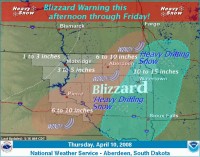
See larger image here
Meanwhile in the warm sector of the storm there is a moderate risk of severe westher over parts of the Mississippi Valley and a slight risk for surrounding areas. Not a superoutbreak but probably one with dozens of severe weather reports with tornadoes, strong wind and hail over the next two days. See the reports from Thursday here.
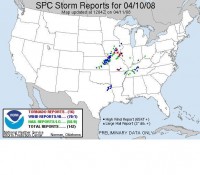
See larger image here
Many areas of the east and south ahead of the storm are enjoying warm spring weather. But by Sunday into early next week, unusual cold weather will settle in for a few days. That could serve to be a problem for the Georgia peach crop (worth $35 million) and other early crops in the southeast. You can track the severe weather here and winter storm and then freeze threat warnings and advisories here.
Apr 09, 2008
Climate Change Confirmed but Global Warming is Cancelled
Owen McShane, New Zealand National Business Review
In December last year, at the UN conference in Bali, I heard Viscount Monckton present a paper prepared by himself, the Australian Dr David Evans and our own Dr Vincent Gray (who were at Bali, too) that showed while the IPCC models predict that greenhouse gases would produce an extensive “hot spot” in the upper troposphere over the tropics, the satellite measurements show no such hotspots have appeared. Monckton and Evans found a large part of this discrepancy is the result of some basic errors in the IPCC’s assessment of the Stefan-Boltzmann equation. When they applied their revised factor to the effect of greenhouse gases, the temperature rise was about a third of that predicted by the IPCC. So by late last year we not only knew IPCC forecasts of atmospheric global warming were wrong; we were beginning to understand why they are wrong.
The climate sceptics have had to explain why the hotspots are not where they should be - not just challenge the theory with their observations. This is why I felt so lucky to be in the right place at the right time when I heard Roy Spencer speak at the New York conference on climate change in March.
Spencer was drawing on observations and measurements from the new Aqua satellites to explain the mechanism behind this anomaly between model forecasts and observation. You may have heard that the IPCC models cannot predict clouds and rain with any accuracy. Their models assume water vapour goes up to the troposphere and hangs around to cook us all in a greenhouse future.
However, there is a mechanism at work that “washes out” the water vapour and returns it to the oceans along with the extra CO2 and thus turns the added water vapour into a NEGATIVE feedback mechanism. The newly discovered mechanism is a combination of clouds and rain (Spencer’s mechanism adds to the mechanism earlier identified by Professor Richard Lindzen called the Iris effect). The IPCC models assumed water vapour formed clouds at high altitudes that lead to further warming. The Aqua satellite observations and Spencer’s analysis show water vapour actually forms clouds at low altitudes that lead to cooling.
This has struck the alarmists like a thunderbolt, especially as the lead author of the IPCC chapter on feedback has written to Spencer agreeing that he is right! There goes the alarmist neighbourhood! Read more here.
Apr 07, 2008
Snow World - What a Year for Snow in Unusual Places
By Joseph D’Aleo on Intellicast
For years, I wrote stories on weather and climate on Intellicast.com. I will be doing weekly stories on the weather there again starting today. The first summarizes the unusual snowy winters of 2007 in the Southern Hemisphere and 2007/08 in the Northern Hemisphere. It snowed in places where snow is rare or unheard of, and many all-time snow records were set in other places used to snow in winter.
Since the article was penned last week, St. Johnsbury, Vermont came in with a new seasonal snow record at the Fairbanks Museum and Planetarium with 139.1 inches, just eclipsing the mark of 139.0 inches set in 1968-69. According to Mark Breen the Museum’s meteorologist, records go back to 1894, and the observing site is essentially the same throughout the period of record. It has been an amazing winter there Mark noted. The snowiest winter season - December, January, and March - with 119 inches, the snowiest December of record - 54.1 inches, the only winter with two months exceeding 40 inches of snowfall, and one of the longest continuous snowcover seasons (they still have 15 inches of snow at the stake).
Also all the way acrosss the country to the northwest, Spokane, Washington found their seasonal total move into second place all-time with 89.4 inches, second only to 1949-50. Stowe, Vermont is pushing 400 inches and Vail, CO 420 inches with another storm brewing. In fact in all these places additional snow is very possible before they put away their snow sticks.
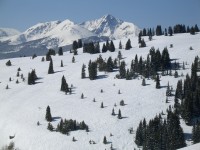
Photo of Vail this week courtesy of Tim Kelley. See larger image here.
In the middle, Minnesota saw a major snowstorm with up to 32 inches of snow that the Minnesota Climatology Working group wrote about here, with another snowstorm on the way.
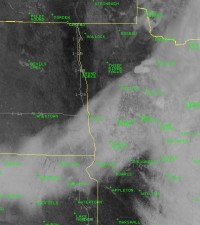
Visible satellite of the recent snowfall 1:15pm CDT on April 7, 2008. There are clouds obscuring the snow over the right side of the photo. Courtesy Grand Forks National Weather Service.
Across the Atlantic, the UK is getting an unusual April snow. Britain saw its worst April snowfall for nearly 20 years yesterday. Up to three inches of snow fell in parts of southern England and temperatures were below freezing in many places even at midday. The Arctic cold snap meant more misery for passengers at Heathrow’s Terminal 5, where British Airways cancelled more than 100 flights. Both Heathrow’s runways briefly closed for de-icing. Gatwick’s runway closed for two hours to clear snow, with 55 flights abandoned.
See the Intellicast story “Snow World - What a Year for Snow in Unusual Places” here.
Apr 06, 2008
Solar Cycle 24: Implications for the United States
By David Archibald at the ICCC
Do we live in a special time in which the laws of physics and nature are suspended? No, we do not. Can we expect relationships between the Sun’s activity and climate, that we can see in data going back several hundred years, to continue for at least another 20 years? With absolute certainty. In this presentation, I will demonstrate that the Sun drives climate, and use that demonstrated relationship to predict the Earth’s climate to 2030. It is a prediction that differs from most in the public domain. It is a prediction of imminent cooling.
The sun reverses magnetic polarity with each solar cycle, and sunspots of the new cycle start forming before the old cycle has completely died off. The average length of a solar cycle is 10.7 years. Solar Cycle 23 started in May 1996, rising to a peak of 120.9 in April 2000. For Solar Cycle 23 to be of average length, Solar Cycle 24 should have started in January 2007. The first sunspots of a new solar cycle appear usually at more than 20 degrees latitude on the Sun’s surface. According to the last couple of solar cycles, the first sunspots appear twelve to twenty months prior to the start of the new cycle. With the first sunspot of Solar Cycle 24 seen on 4th January, 2008, Solar Cycle 24 may start from late 2008 to mid-2009.
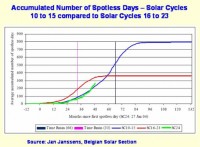
See larger image here
This graph is another pointer that we are heading back to the weak solar cycles of the 19th century, with 19th century type winters to accompany them. Solar cycles 10 to 15, from 1860 to 1917, had an average of 66 months from the first spotless day to solar cycle minimum. This was a time of considerable glacial advance in the European Alps. Since then, solar cycles have averaged half that at 33 months from first spotless day to solar cycle minimum. So far, solar cycle 24 is plotting on the 19th century line. With the first spotless day on 27th January, 2004, and if the 66 month observation holds, then solar minimum will be on or about July 2009. This would make solar cycle 23 thirteen years long.
Combining the rural US data set we saw earlier and the projected temperature response to the length of Solar Cycle 23, this graph shows the expected decline to 2030.
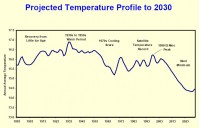
See larger image here
The temperature decline will be as steep as that of the 1970s cooling scare, but will go on for longer. It can get worse than a repeat of the Dalton Minimum. Ken Schatten is the solar physicist with the best track record in predicting solar cycles. His work suggests a return to the advancing glaciers and delayed spring snow melt of the Little Ice Age, for an indeterminate period. He told the American Astronomical Association Meeting in 2003 that based on his model “The surprising result of these long-range predictions is a rapid decline in solar activity, starting with cycle #24. If this trend continues, we may see the Sun heading towards a “Maunder” type of solar activity minimum - an extensive period of reduced levels of solar activity.” See this full paper that makes the case for the role of the sun in driving climate (with some US city data and forecasts) and for the folly of being so concerened about carbon here.
Apr 05, 2008
BBC Keeps on Denying the Sun’s Influence on Climate
By Warwick Hughes
Here is a recent email headed “Black Propaganda continues at the BBC” from JohnA informing Richard Black of the BBC about the degree of bias in BBC reporting on climate issues. (Can I just add here my humble effort ”Exactly where Lockwood and Frohlich are wrong” ?)
Richard,
I note your latest attempt in your continuing campaign to ignore and demean the considerable and growing evidence of natural influences on climate change, and especially on the cosmic ray/solar cycle hypothesis of Svensmark et al. Last time you raced out of the blocks with an article entitled “No Sun link’ to climate change” about a paper then yet to be published, and couldn’t be bothered beyond leaving a few voicemail messages to contact Dr Svensmark for a response. The paper of course was by Lockwood and Froelich: Then of course, you didn’t bother reporting that reply from Svensmark because we don’t want the license payers unnecessarily confused with a solid rebuttal, would we Richard? Especially since that paper by Lockwood that you trumpeted was rife with errors.
Here’s the reply from Svensmark. Here’s another from Ken Gregory and here’s another from Anthony Watts.
Obviously you won’t spend any time reporting on them, because life’s too short isn’t it Richard? After all, what with burning up all of those carbon credits to visit glaciers calving perfectly naturally, and polar bear populations stridently not declining but growing strongly, there’s no time for nuanced scientific reporting is there?
Now we have yet another example of your tawdry one-sided reporting with this one: ”“No Sun link’ to climate change” (by the way, are you minimizing your carbon footprint by recycling the titles to articles?). This time its a letter to a little known and little read environmental science journal - so we’re a long way from any expertise in statistics or solar science, aren’t we? This time the two scientists are Sloan and Wolfendale, and would you believe it! They come to the same conclusion as the one you want to hear!
Read more of this powerful letter here.
|








